China’s Trade of Agricultural Products Drives Substantial Greenhouse Gas Emissions
Abstract
1. Introduction
2. Data and Methodology
2.1. Accounting Method
2.2. Data Sources
3. Results
3.1. GHG Emissions Embodied in China’s Agricultural Product Exports
3.2. GHG Emissions Embodied in China’s Agricultural Product Imports
3.3. GHG Emissions Embodied in the Net Trade of Agricultural Products
4. Discussion
4.1. GHG Emissions Associated with China’s Trade of Agricultural Products
4.2. CEFs of Agricultural Products
4.3. Comparison of Different CEF Benchmarks
4.4. Limitations
5. Conclusions
Supplementary Materials
Author Contributions
Funding
Institutional Review Board Statement
Informed Consent Statement
Data Availability Statement
Conflicts of Interest
References
- Zurek, M.; Hebinck, A.; Selomane, O. Climate change and the urgency to transform food systems. Science 2022, 376, 1416–1421. [Google Scholar] [CrossRef] [PubMed]
- Crippa, M.; Solazzo, E.; Guizzardi, D.; Monforti-Ferrario, F.; Tubiello, F.N.; Leip, A. Food systems are responsible for a third of global anthropogenic GHG emissions. Nat. Food 2021, 2, 198–209. [Google Scholar] [CrossRef]
- Frank, S.; Beach, R.; Havlik, P.; Valin, H.; Herrero, M.; Mosnier, A.; Hasegawa, T.; Creason, J.; Ragnauth, S.; Obersteiner, M. Structural change as a key component for agricultural non-CO2 mitigation efforts. Nat. Commun. 2018, 9, 1060. [Google Scholar] [CrossRef] [PubMed]
- Suh, S.; Johnson, J.A.; Tambjerg, L.; Sim, S.; Broeckx-Smith, S.; Reyes, W.; Chaplin-Kramer, R. Closing yield gap is crucial to avoid potential surge in global carbon emissions. Glob. Environ. Chang.-Hum. Policy Dimens. 2020, 63, 102100. [Google Scholar] [CrossRef]
- Ou, Y.; Roney, C.; Alsalam, J.; Calvin, K.; Creason, J.; Edmonds, J.; Fawcett, A.A.; Kyle, P.; Narayan, K.; O’Rourke, P.; et al. Deep mitigation of CO2 and non-CO2 greenhouse gases toward 1.5 degrees C and 2 degrees C futures. Nat. Commun. 2021, 12, 6245. [Google Scholar] [CrossRef]
- WTO (World Trade Organization). Available online: https://stats.wto.org/ (accessed on 14 March 2022).
- Zhao, X.L.; Wu, X.F.; Guan, C.H.; Ma, R.; Nielsen, C.P.; Zhang, B. Linking Agricultural GHG Emissions to Global Trade Network. Earth’s Future 2020, 8, e2019EF001361. [Google Scholar] [CrossRef]
- Food and Agricultural Organization of the United Nations (FAOSTAT). Crop Prospects and Food Situation. Available online: http://www.fao.org/3/ca5327en/ca5327en.pdf (accessed on 14 February 2022).
- NBSC. National Bureau of Statistics of China. Available online: https://www.stats.gov.cn/tjsj/ndsj/# (accessed on 14 February 2022).
- IEA. The 2006 IPCC Guidelines for National Greenhouse Gas Inventories. Available online: https://www.iea.org/data-and-statistics/data-browser/?country=CHINAREG&fuel=CO2%20emissions&indicator=CO2BySector/ (accessed on 12 February 2022).
- UNEP (United Nations Environment Programme). Available online: https://www.unep.org/resources?f%5B0%5D=category%3A452 (accessed on 14 March 2022).
- MEE. The People’s Republic of China Second Biennial Update Report on Climate Change. Available online: https://www.mee.gov.cn/ywgz/ydqhbh/wsqtkz/201907/P020190701765971866571.pdf/ (accessed on 4 July 2022).
- D’Odorico, P.; Carr, J.A.; Laio, F.; Ridolfi, L.; Vandoni, S. Feeding humanity through global food trade. Earth’s Future 2014, 2, 458–469. [Google Scholar] [CrossRef]
- Wiedmann, T.; Lenzen, M.; Turner, K.; Barrett, J. Examining the global environmental impact of regional consumption activities—Part 2: Review of input-output models for the assessment of environmental impacts embodied in trade. Ecol. Econ. 2007, 61, 15–26. [Google Scholar] [CrossRef]
- Mi, Z.F.; Zhang, Y.K.; Guan, D.B.; Shan, Y.L.; Liu, Z.; Cong, R.G.; Yuan, X.C.; Wei, Y.M. Consumption-based emission accounting for Chinese cities. Appl. Energy 2016, 184, 1073–1081. [Google Scholar] [CrossRef]
- Meng, J.; Mi, Z.F.; Guan, D.B.; Li, J.S.; Tao, S.; Li, Y.; Feng, K.S.; Liu, J.F.; Liu, Z.; Wang, X.J.; et al. The rise of South-South trade and its effect on global CO2 emissions. Nat. Commun. 2018, 9, 1871. [Google Scholar] [CrossRef]
- Wang, X.; Liu, H.; Lv, Z.; Deng, F.; Xu, H.; Qi, L.; Shi, M.; Zhao, J.; Zheng, S.; Man, H.; et al. Trade-linked shipping CO2 emissions. Nat. Clim. Chang. 2021, 11, 945–951. [Google Scholar] [CrossRef]
- Hochman, Z.; Gobbett, D.L.; Horan, H. Climate trends account for stalled wheat yields in Australia since 1990. Glob. Chang. Biol. 2017, 23, 2071–2081. [Google Scholar] [CrossRef] [PubMed]
- Wang, L.Z.; Xue, B.; Yan, T.H. Greenhouse gas emissions from pig and poultry production sectors in China from 1960 to 2010. J. Integr. Agric. 2017, 16, 221–228. [Google Scholar] [CrossRef]
- Ammar, H.; Abidi, S.; Ayed, M.; Moujahed, N.; Marti, M.; Chahine, M.; Bouraoui, R.; Lopez, S.; M’Hamed, H.C.; Hechlef, H. Estimation of Tunisian Greenhouse Gas Emissions from Different Livestock Species. Agriculture 2020, 10, 562. [Google Scholar] [CrossRef]
- Sporchia, F.; Kebreab, E.; Caro, D. Assessing the multiple resource use associated with pig feed consumption in the European Union. Sci. Total Environ. 2021, 759, 144306. [Google Scholar] [CrossRef]
- Zhen, W.; Qin, Q.D.; Qian, X.Y.; Wei, Y.M. Inequality across China’s Staple Crops in Energy Consumption and Related GHG Emissions. Ecol. Econ. 2018, 153, 17–30. [Google Scholar] [CrossRef]
- Zhang, F.; Liu, F.; Ma, X.; Guo, G.; Liu, B.; Cheng, T.; Liang, T.; Tao, W.; Chen, X.; Wang, X. Greenhouse gas emissions from vegetables production in China. J. Clean. Prod. 2021, 317, 128449. [Google Scholar] [CrossRef]
- Chen, X.H.; Ma, C.C.; Zhou, H.M.; Liu, Y.; Huang, X.M.; Wang, M.K.; Cai, Y.Y.; Su, D.; Muneer, M.A.; Guo, M.C.; et al. Identifying the main crops and key factors determining the carbon footprint of crop production in China, 2001–2018. Resour. Conserv. Recycl. 2021, 172, 105661. [Google Scholar] [CrossRef]
- Friel, S.; Schram, A.; Townsend, B. The nexus between international trade, food systems, malnutrition and climate change. Nat. Food 2020, 1, 51–58. [Google Scholar] [CrossRef]
- Verburg, R.; Stehfest, E.; Woltjer, G.; Eickhout, B. The effect of agricultural trade liberalisation on land-use related greenhouse gas emissions. Glob. Environ. Chang.-Hum. Policy Dimens. 2019, 19, 434–446. [Google Scholar] [CrossRef]
- Springmann, M.; Clark, M.; Mason-D’Croz, D.; Wiebe, K.; Bodirsky, B.L.; Lassaletta, L.; Vries, D.W.; Vermeulen, S.J.; Herrero, M.; Carlson, K.M.; et al. Options for keeping the food system within environmental limits. Nature 2018, 562, 519–525. [Google Scholar] [CrossRef] [PubMed]
- Janssens, C.; Havlík, P.; Krisztin, T.; Baker, J.; Frank, S.; Hasegawa, T.; Ohrel, S.; Ragnauth, S.; Schmid, E.; Valin, H.; et al. Global hunger and climate change adaptation through international trade. Nat. Clim. Chang. 2020, 10, 829–835. [Google Scholar] [CrossRef] [PubMed]
- Lin, J.Y.; Hu, Y.C.; Cui, S.H.; Kang, J.F.; Xu, L.L. Carbon footprints of food production in China (1979–2009). J. Clean Prod. 2015, 90, 97–103. [Google Scholar]
- Kim, D.H.; Suen, Y.B.; Lin, S.C. Carbon dioxide emissions and trade: Evidence from disaggregate trade data. Energy Econ. 2017, 78, 13–28. [Google Scholar] [CrossRef]
- Li, J.J.; Chandio, A.A.; Liu, Y.C. Trade Impacts on Embodied Carbon Emissions-Evidence from the Bilateral Trade between China and Germany. Int. J. Environ. Res. Public Health 2020, 17, 5076. [Google Scholar] [CrossRef] [PubMed]
- He, R.R.; Zhu, D.; Chen, X.W.; Cao, Y.; Chen, Y.Q.; Wang, X.L. How the trade barrier changes environmental costs of agricultural production: An implication derived from China’s demand for soybean caused by the US-China trade war. J. Clean. Prod. 2019, 227, 578–588. [Google Scholar] [CrossRef]
- Elobeid, A.; Carriquiry, M.; Dumortier, J.; Swenson, D.; Hayes, D. China-US trade dispute and its impact on global agricultural markets, the US economy, and greenhouse gas emissions. J. Agric. Econ. 2021, 72, 647–672. [Google Scholar] [CrossRef]
- Kim, T.J.; Tromp, N. Carbon emissions embodied in China-Brazil trade: Trends and driving factors. J. Clean. Prod. 2021, 293, 126206. [Google Scholar] [CrossRef]
- Peng, Y.F.; Chen, W.D.; Wei, P.B. Examining the comprehensive effects of renewable energy, forest, and agriculture on CO2 emissions: Evidences from China and India. Fresenius Environ. Bull. 2019, 28, 8708–8720. [Google Scholar]
- Chen, K.J.; Huang, T.; Zhang, X.D.; Liu, X.R.; Jian, X.H.; Zhugu, R.; Wang, L.F.; Tao, S.; Liu, J.F.; Gao, H.; et al. Drivers of Global Methane Emissions Embodied in International Beef Trade. Environ. Sci. Technol. 2022, 56, 11256–11265. [Google Scholar] [CrossRef]
- IPCC. The 2006 IPCC Guidelines for National Greenhouse Gas Inventories. Available online: http://www.ipcc-nggip.iges.or.jp/ (accessed on 14 July 2022).
- Hawkins, J.; Ma, C.B.; Schilizzi, S.; Zhang, F. Apples to kangaroos: A framework for developing internationally comparable carbon emission factors for crop and livestock products. J. Clean. Prod. 2016, 139, 460–472. [Google Scholar] [CrossRef]
- CCSY. China Customs Statistics Yearbooks 1996–2016; China Customs Press: Beijing, China, 1996–2016. [Google Scholar]
- Huang, G.R.; Yao, G.L.; Zhao, J.; Lisk, M.D.; Yu, C.Q.; Zhang, X. The environmental and socioeconomic trade-offs of importing crops to meet domestic food demand in China. Environ. Res. Lett. 2019, 14, 5076. [Google Scholar] [CrossRef]
- Chen, B.; Yang, Q.; Li, J.S.; Chen, G.Q. Decoupling analysis on energy consumption, embodied GHG emissions and economic growth—The case study of Macao. Renew. Sustain. Energy Rev. 2017, 67, 662–672. [Google Scholar] [CrossRef]
- White, R.R.; Hall, M.B. Nutritional and greenhouse gas impacts of removing animals from US agriculture. Proc. Natl. Acad. Sci. USA 2017, 114, E10301–E10308. [Google Scholar] [CrossRef]
- Chen, B.; Li, J.S.; Zhou, S.L.; Yang, Q.; Chen, G.Q. GHG emissions embodied in Macao’s internal energy consumption and external trade: Driving forces via decomposition analysis. Renew. Sustain. Energy Rev. 2018, 82, 4100–4106. [Google Scholar] [CrossRef]
- Zhang, B.; Zhao, X.; Wu, X.; Han, M.; Guan, C.H.; Song, S. Consumption-Based Accounting of Global Anthropogenic CH4 Emissions. Earth’s Future 2018, 6, 1349–1363. [Google Scholar] [CrossRef]
- Zhang, B.; Jin, P.; Qiao, H.; Hayat, T.; Alsaedi, A.; Ahmad, B. Exergy analysis of Chinese agriculture. Ecol. Indic. 2019, 105, 279–291. [Google Scholar] [CrossRef]
- Zhao, H.; Chang, J.; Havlík, P.; van Dijk, M.; Valin, H.; Janssens, C.; Ma, L.; Bai, Z.; Herrero, M.; Smith, P.; et al. China’s future food demand and its implications for trade and environment. Nat. Sustain. 2021, 4, 1042–1051. [Google Scholar] [CrossRef]
- Li, Y.L.; Chen, B.; Chen, G.Q. Carbon network embodied in international trade: Global structural evolution and its policy implications. Energy Policy 2020, 139, 111316. [Google Scholar] [CrossRef]
- Herrero, M.; Gerber, P.; Vellinga, T.; Garnett, T.; Leip, A.; Opio, C.; Westhoek, H.J.; Thornton, P.K.; Olesen, J.; Hutchings, N.; et al. Livestock and greenhouse gas emissions: The importance of getting the numbers right. Anim. Feed Sci. Technol. 2011, 166–167, 779–782. [Google Scholar] [CrossRef]
- Food and Agricultural Organization of the United Nations. Food and Agriculture Data. 2022. Available online: http://www.fao.org/faostat/en/ (accessed on 25 February 2022).
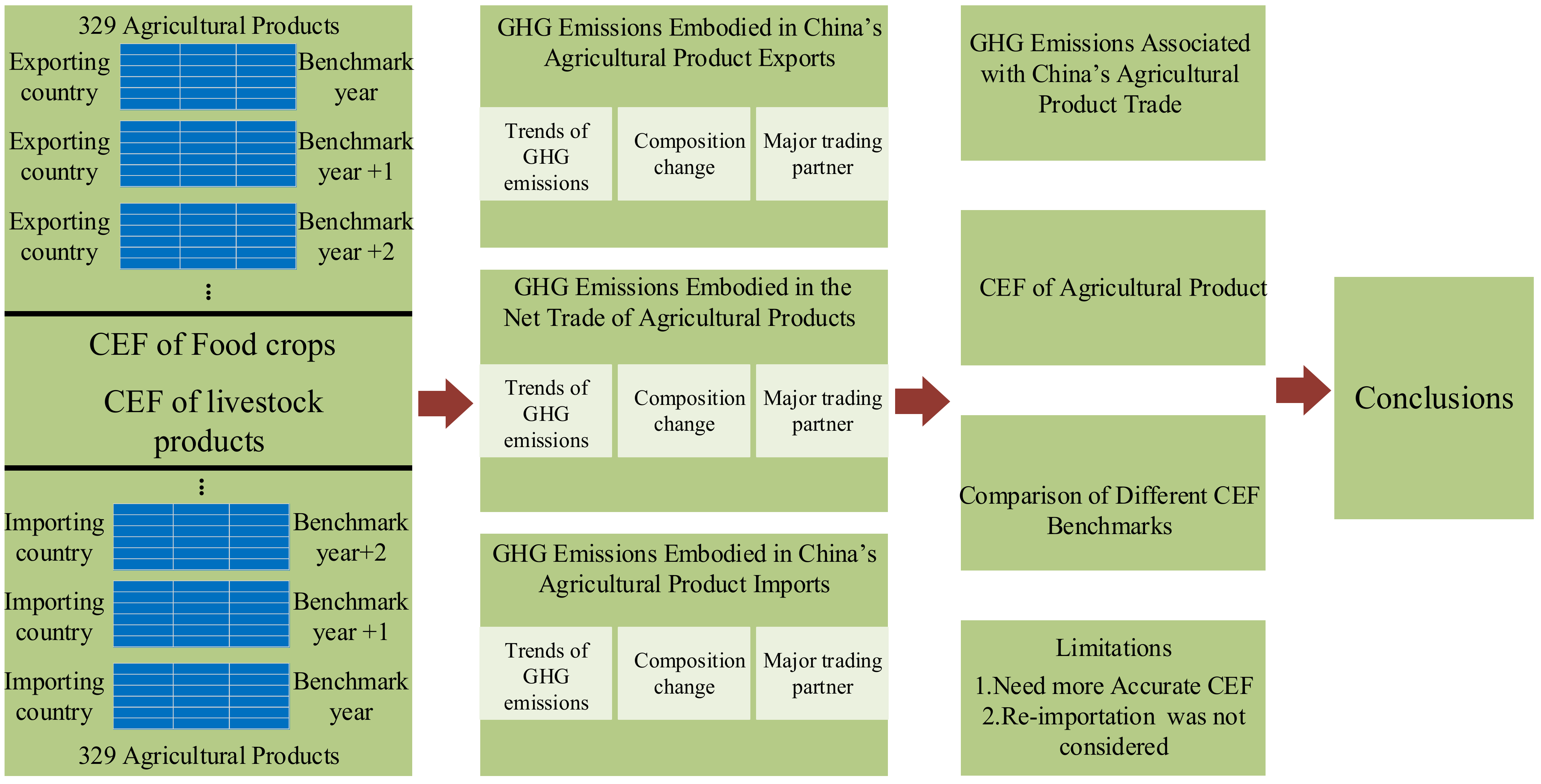
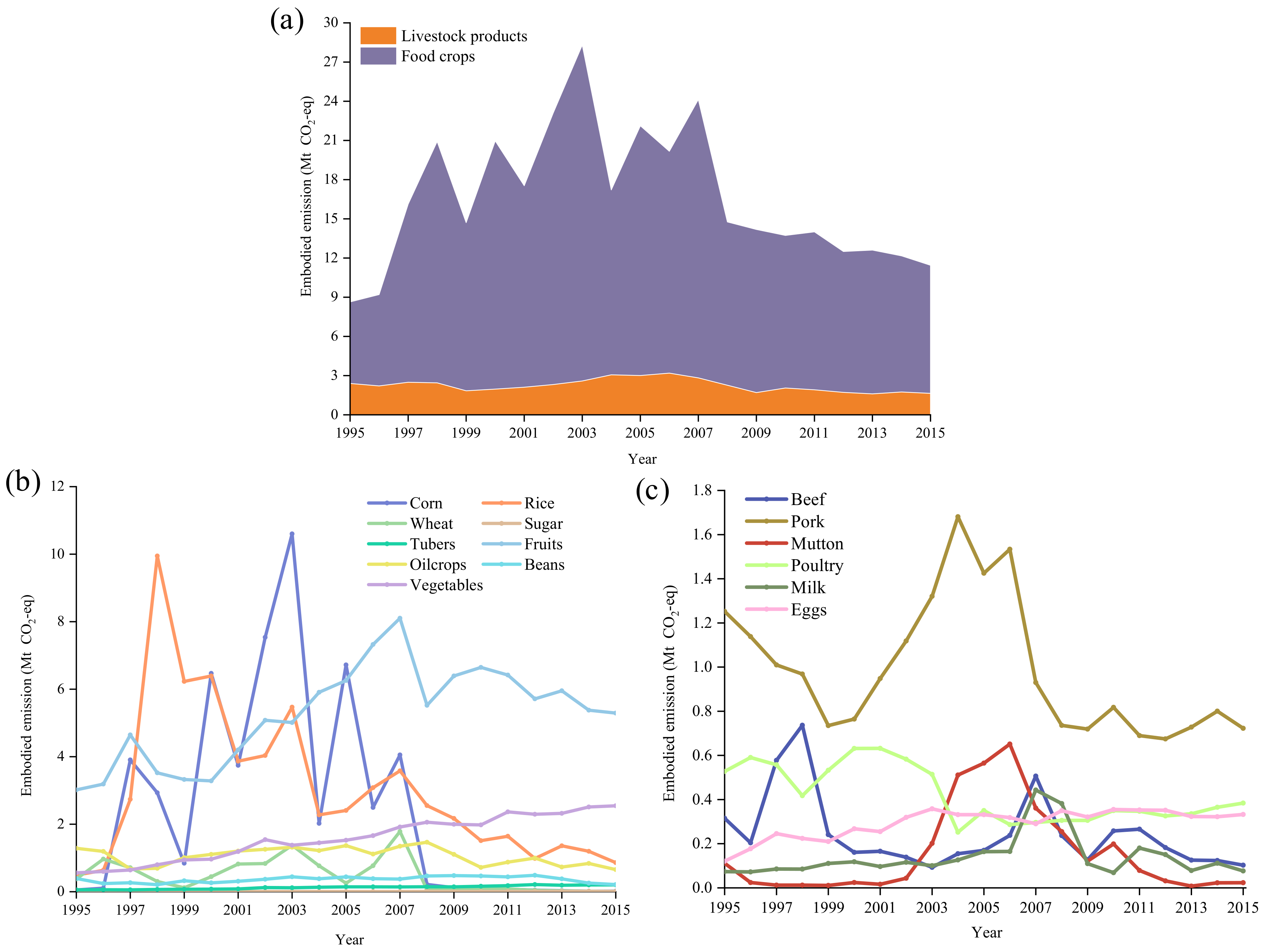
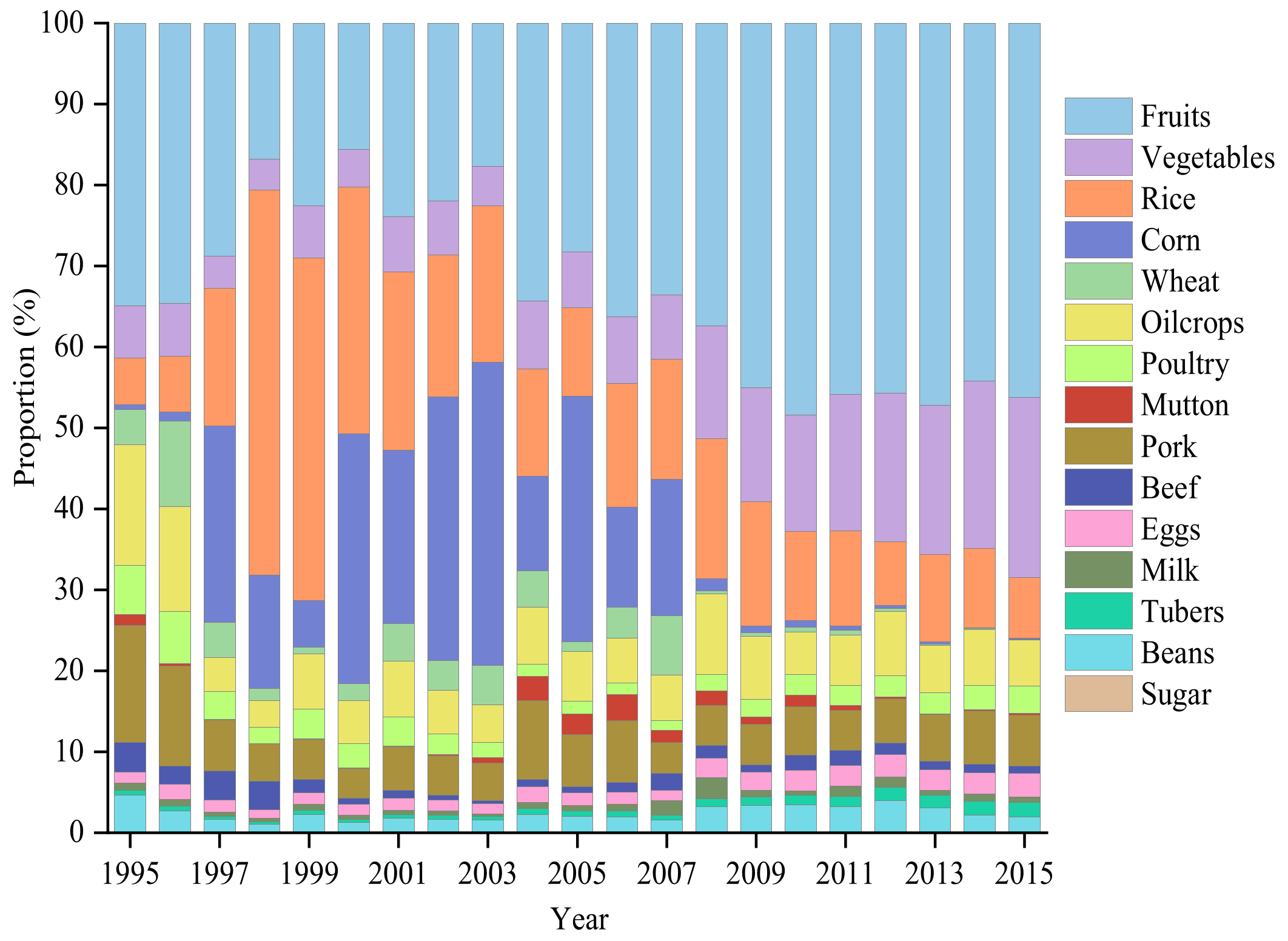
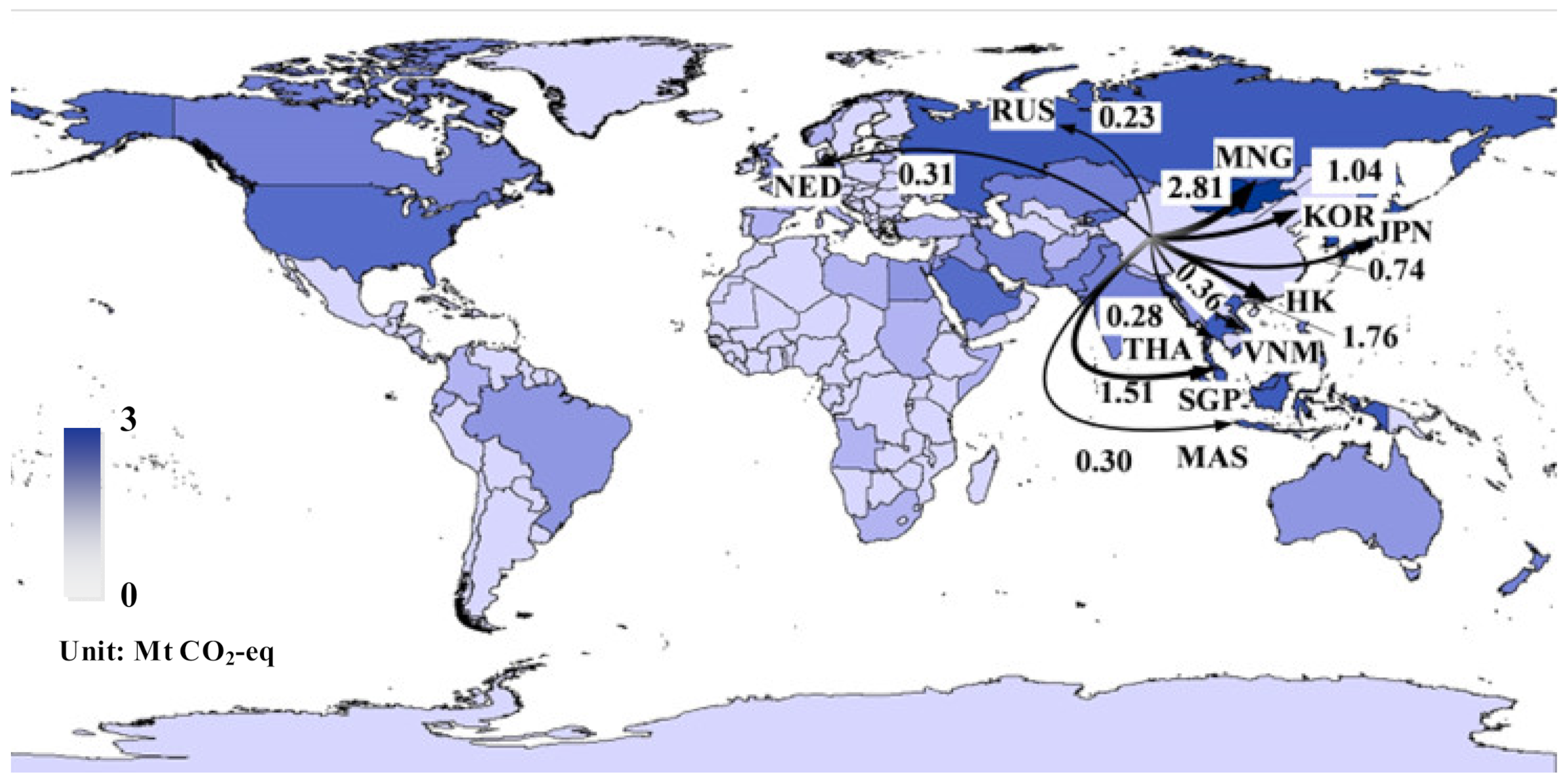
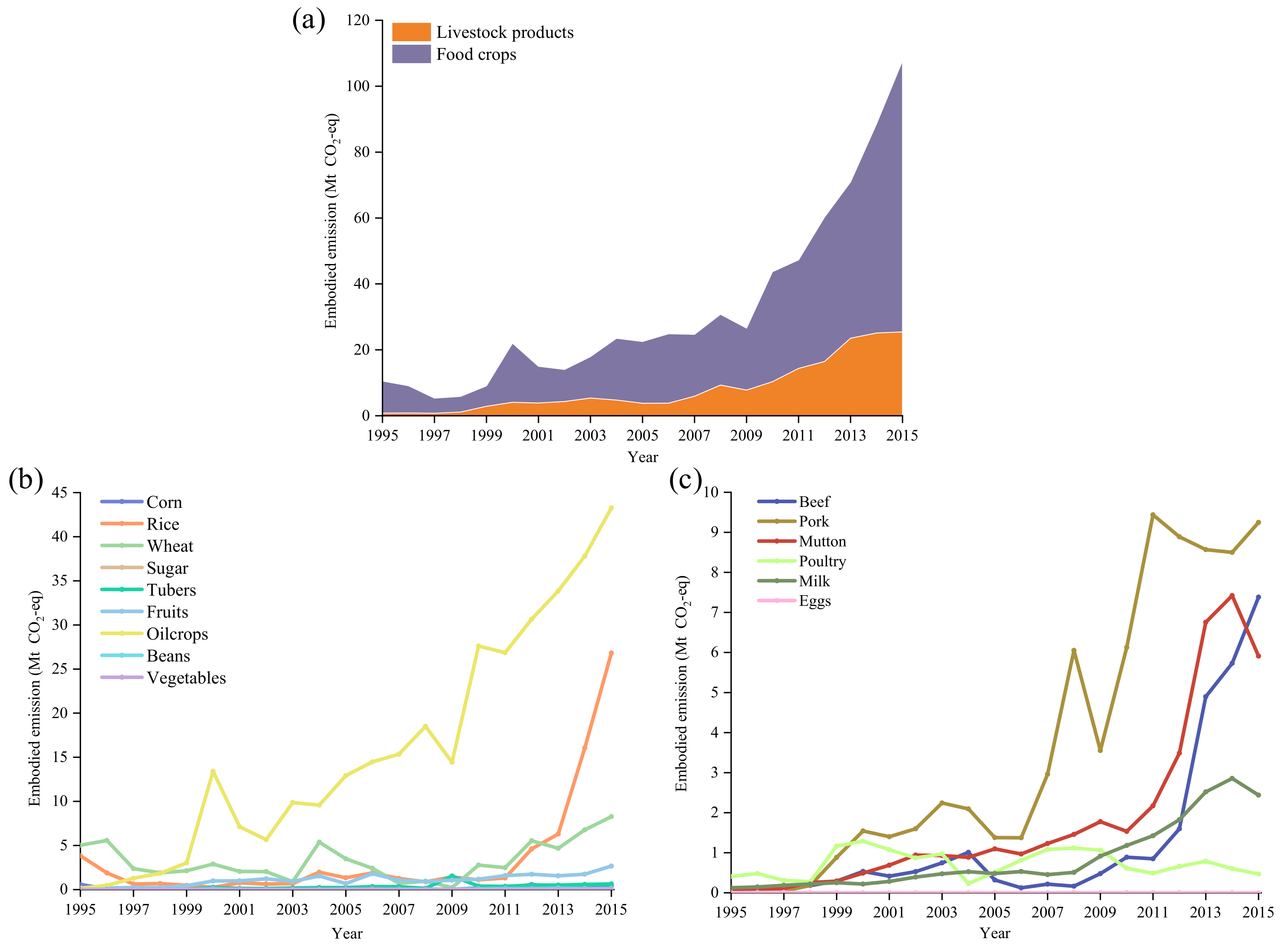
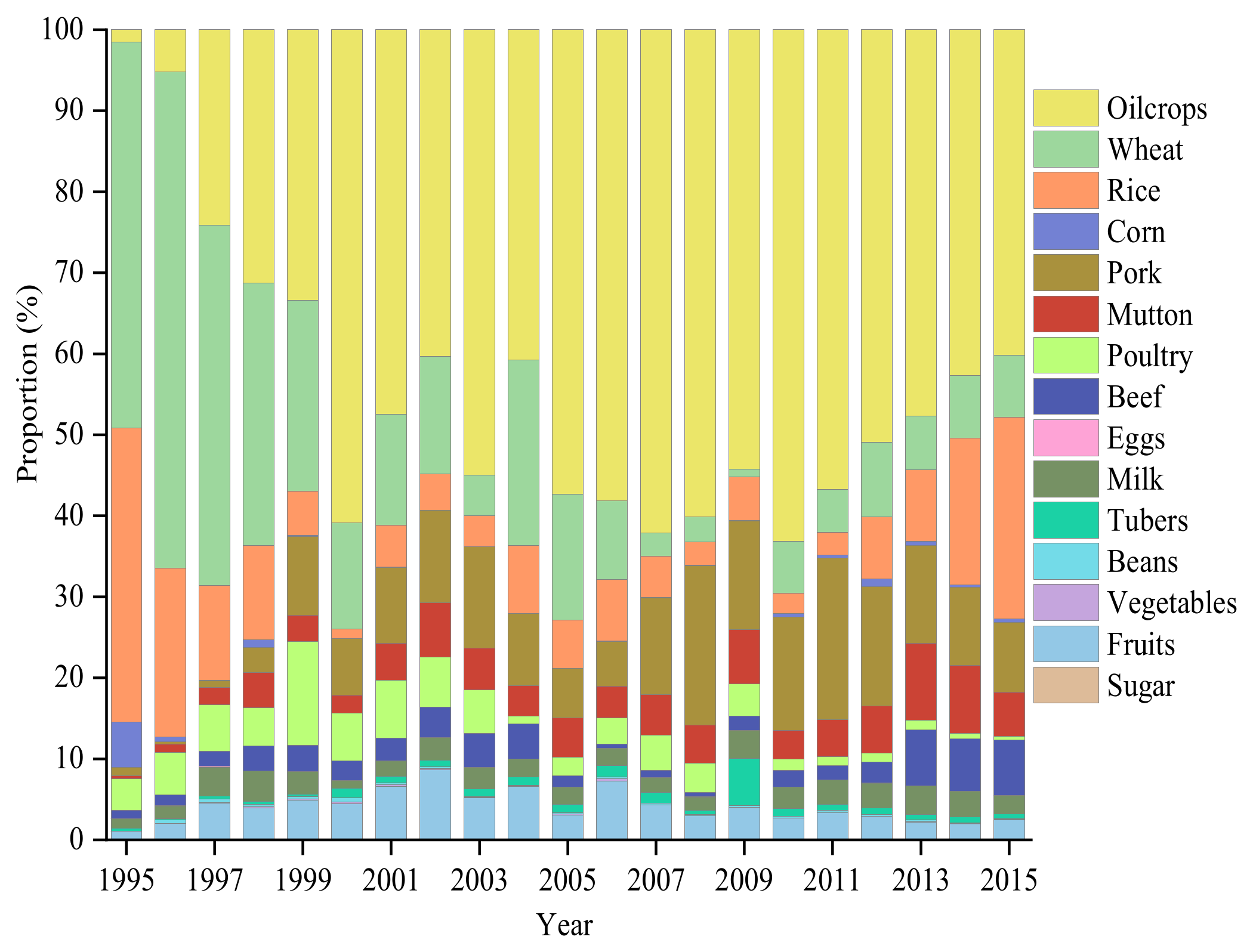

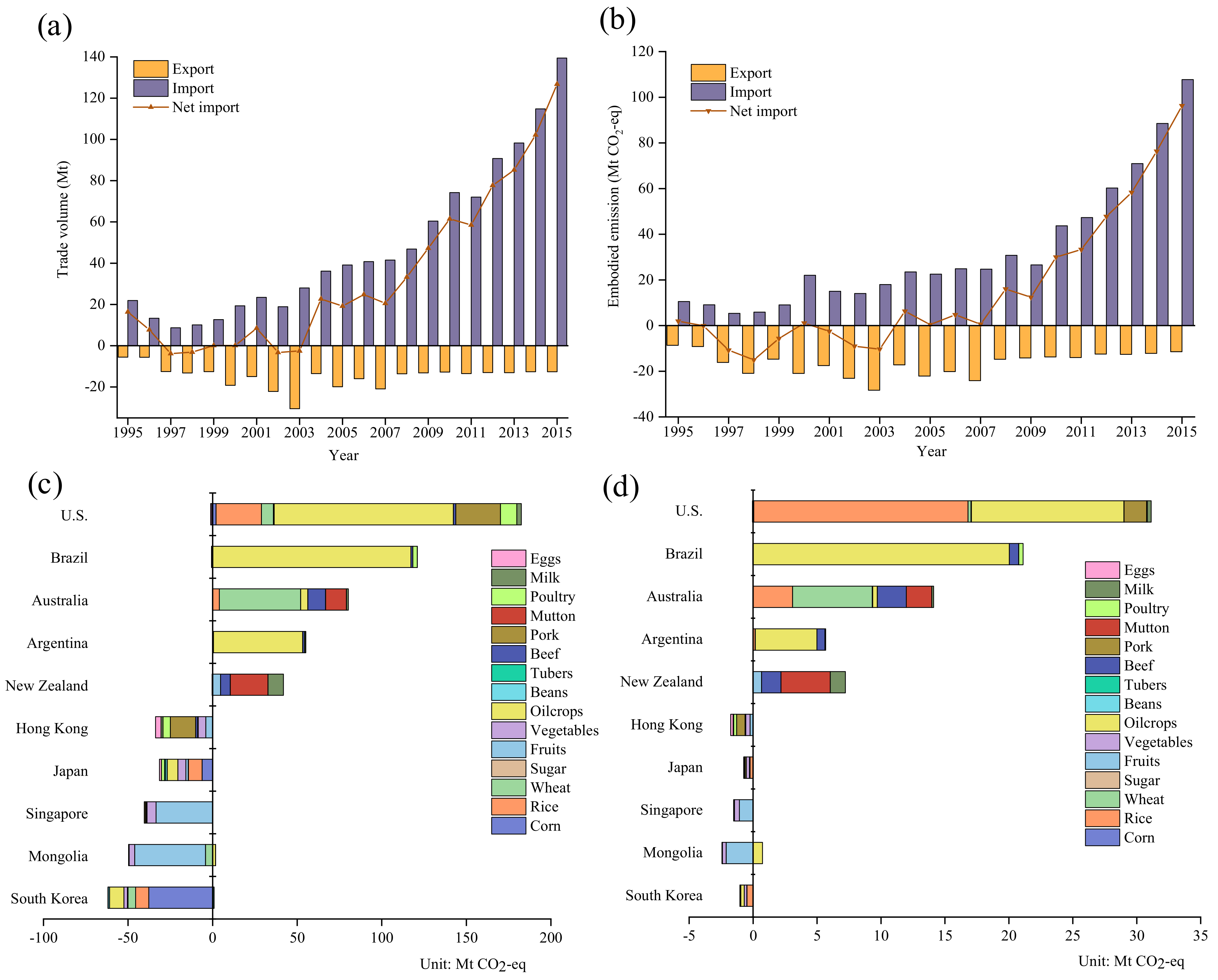
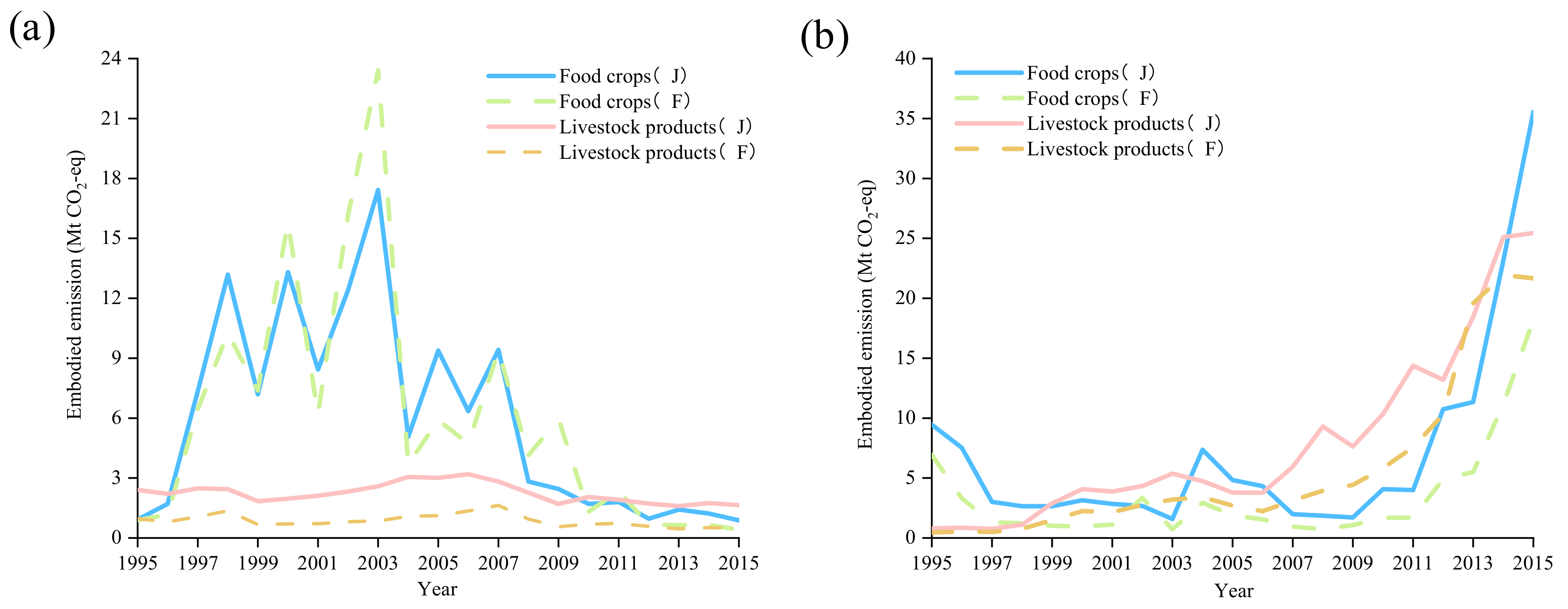
| Item | Domestic Production (Mt) | Domestic Consumption (Mt) | Supply Rate |
|---|---|---|---|
| Production/Consumption | |||
| Grain | 563.1 | 469.3 | 112.0% |
| Fruit | 271.0 | 265.9 | 101.9% |
| Vegetables | 769.2 | 840.3 | 91.5% |
| Meat | 84.5 | 86.1 | 98.2% |
| Milk | 38.7 | 43.6 | 88.9% |
| Sugar | 11.6 | 15.6 | 74.4% |
| Oil crops | 24.0 | 68.7 | 35.0% |
| Beans | 11.8 | 87.7 | 13.4% |
Publisher’s Note: MDPI stays neutral with regard to jurisdictional claims in published maps and institutional affiliations. |
© 2022 by the authors. Licensee MDPI, Basel, Switzerland. This article is an open access article distributed under the terms and conditions of the Creative Commons Attribution (CC BY) license (https://creativecommons.org/licenses/by/4.0/).
Share and Cite
Meng, Z.; Guo, J.; Yan, K.; Yang, Z.; Li, B.; Zhang, B.; Chen, B. China’s Trade of Agricultural Products Drives Substantial Greenhouse Gas Emissions. Int. J. Environ. Res. Public Health 2022, 19, 15774. https://doi.org/10.3390/ijerph192315774
Meng Z, Guo J, Yan K, Yang Z, Li B, Zhang B, Chen B. China’s Trade of Agricultural Products Drives Substantial Greenhouse Gas Emissions. International Journal of Environmental Research and Public Health. 2022; 19(23):15774. https://doi.org/10.3390/ijerph192315774
Chicago/Turabian StyleMeng, Zheng, Jinling Guo, Kejia Yan, Zhuan Yang, Bozi Li, Bo Zhang, and Bin Chen. 2022. "China’s Trade of Agricultural Products Drives Substantial Greenhouse Gas Emissions" International Journal of Environmental Research and Public Health 19, no. 23: 15774. https://doi.org/10.3390/ijerph192315774
APA StyleMeng, Z., Guo, J., Yan, K., Yang, Z., Li, B., Zhang, B., & Chen, B. (2022). China’s Trade of Agricultural Products Drives Substantial Greenhouse Gas Emissions. International Journal of Environmental Research and Public Health, 19(23), 15774. https://doi.org/10.3390/ijerph192315774






